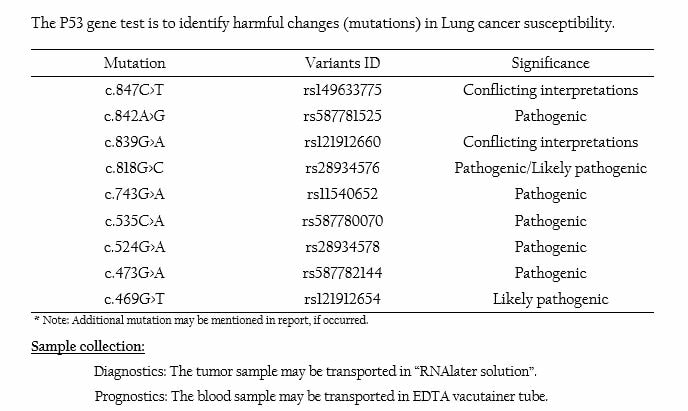Lung Cancer P53 Mutation Panel
p53 overview:
p53 mutation in Lung Cancer:
- P53 is a tumor suppressor proteins also called as the “guardian of cells”.
- Also help in protecting the body from DNA damage, progression of cancer and also help in maintaining gene integrity.
- p53 acts as a defence in protecting the cell from being damaged due to various external factors such as chemicals, ionising radiations etc.
- p53 is generally found in low levels but is increased greatly during DNA damage as an initiative measure.
- In case of severe damage, it initiates the process of apoptosis thereby permanently removing the damage.
- General mechanism of p53 is that it binds with the genome there by stimulating another functionally important gene for the production of p21, which interacts with CKD2-na cell division stimulating protein thereby inhibiting the cell from passing to the next stage of the cell division [1].
- p53 restricts the tumor development by acting as the sensor of cellular stress by responding to wide range of signals including DNA damage, hypoxia, oncogene expression, nutrient deprivation etc.
p53 mutation in Lung Cancer:
- p53 mutational inactivation is one of the major causes of cancer formation, progression and can cause the cancerous cells to metastasize.
- Over 50% of the cancer occurs due to the mutation in p53 gene.
- In lung cancer, Non-small cell lung carcinoma (NSCLC) and small cell lung carcinoma (SCLC) are reported that regions of the short arm of chromosome 17 frequently deleted, often along with point mutations in the remaining TP53 allele[2]
- Lung carcinoma found in patients who are non-smokers, tend to have germline mutations of TP53 gene[3]
- One of the leading risk factors for lung cancer is undoubtedly tobacco smoking, and the risk for lung cancer increases with the number of cigarettes smoked and the duration of smoking[4]
- When the carcinogens in tobacco smoke are exposed to the epithelium of the lungs, increases lung cancer susceptibility due to the production of oncogenic mutations
- Abnormality of the TP53 in lung cancers has been shown to be associated with a poorer survival prognosis and increased cellular resistance to therapy[5&6]
- Lung cancer, predominantly NSCLC is the leading cause of cancer mortality worldwide[7]
- The lung incidence rate increases annually with an incidence rate of about one million new cases registered per year [8]
- Patients with tobacco-associated cancer have a higher frequency (26%– 71%) of TP53 mutations than patients who never smoked (8%–47%)[9&10]
- It has been noticed that TP53 mutations are closely related to smokers whereas EGFR mutations are statistically more frequent in females and never smokers with adenocarcinoma[11]
- There is a much greater prognostic effect of TP53 mutations in patients with more advanced stage (stages IIIB and IV)[12]
- In preclinical studies with lung cancer cell lines expressing mutated TP53, the TP53 replacement strategy has showed improved chemotherapy and radiotherapy responses[13]
- Bethesda. (1998). National Center for Biotechnology Information, https://www.ncbi.nlm.nih.gov/books/NBK22268/)
- Chiba I, et al. (1990). Oncogene. 5(10): 1603-10.
- Malkin D, et al. (1990). Science. 250(4985):1233-8.
- Hecht SS. (2008). " Chemical Research in Toxicology, 21(1): 160-171.
- Baumann M, Zips D and Appold S. (2009)."Radiotherapy and Oncology, 91(3); 279-281.
- Viktorsson K, De Petris L and Lewensohn R. (2005). Biochemical and Biophysical Research Communications, 331(3); 868-880,
- Jemal A, Siegel R, Ward E, et al. (2008) CA Cancer J Clin. 58:71-96.
- Torre LA, Bray F, Siegel RL, et al. (2015). CA Cancer J Clin 65:87-108.
- Husgafvel-Pursiainen K, Boffetta P, Kannio A, et al. (2000). Cancer Research, 60(11);2906-2911.
- Vah¨ akangas KH, Bennett WP, Castren K, et al. (2001)."Cancer Research, 61(11); 4350- 4356.
- Gow CH, Chang YL, Hsu YC, et al. (2009)."Annals of Oncology, 20(4); 696-702.
- Mitsudomi T, Oyama T, Kusano T, et al. (1993). J Natl Cancer Inst 85; 2018-2023.
- Roth JA, Nguyen D, Lawrence DD, et al, (1996)." Nature Medicine, 2(9); 985-991.

